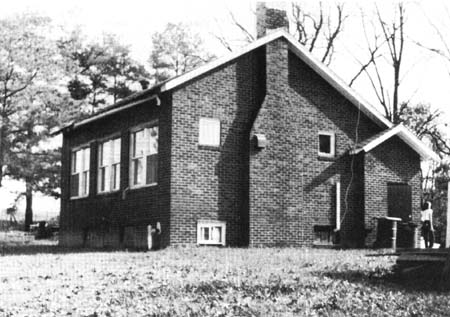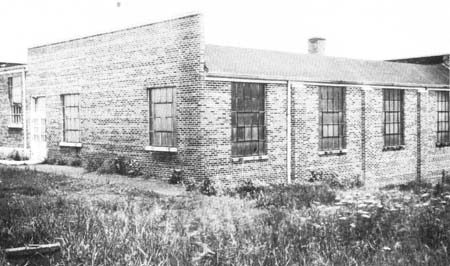|
|
|
|
. |
Back row: 1. Raymond King 2. Verba Gullett
3. Roby Guilett 4. Rachel Julian 5. Emery Randolph 6. Ruby
Gullett 7. Ralph Randolph. Middle: 1. Lowell Taylor 2.
Murray Barger 3. Almon Killingsworth 4. Luther Randolph 5.
Amos Killingsworth 6. Golda Hamilton 7. Lloyd Gullett 8. Gus
McDonald 9. Brantly Anderson 10. Earl Randolph 11. Ralph
Gullett 12. Lucian Anderson 13. Roy McDonald 14. Coy Randolph
15. Norvin Julian 16. Dick McDonald, teacher (turtleneck
shirt). (Coy Randolph in front of teacher, Norvin Julian in
back.) From Log Cabin to Unit District Mildred B. McCormick Many of us who have reached the age of indulging in nostalgia hold the same bygone structure in mind as our symbol of the past in Pope County education. But the one-room school, one in each of 75 districts, at one time, was only one stage of an educational system that brought us to one single-unit district on 1 July, 1958 and to a single-district, two-building educational center in the 1971-72 school year. Among the first classes taught in frontier settlements were the subscription schools in which a teacher contracted with parents to teach the three R's for a stated amount per pupil. One of my ancestors made his own desk which he carried with him from place to place-wherever space could be found for a classroom. Students brought their own supplies, sometimes including a candle stuck in a turnip, according to John W. Allen, the late SIU professor and historian. These schools evolved into penmanship and singing schools. We remember the singing schools here in Pope County. The perlxnanship classes are less talked-about, but I remember the late Faye King Jinhoff, Eddyville, who later became Presidential Inaugural Calligrapher for Presidents Roosevelt through Nixon, mentioned attending special classes. (John Allen, in Legends & Lore, tells the origin of the fancy script known as Spencerian writing. It was taught by Platt Roger Spencer, age 14, in Conneaut,Ohio. In 1848 he published his copybook of penmanship long before Palmer became the accepted guru.) One type of subscription school, though it was not called by that name, was very important in Pope County education. This was the summer school, sometimes known as select school, which trained early teachers and helped make it possible for them to pass teachers' exams and obtain certificates to teach. I have written more fully of these schools in the June 1990 Springhouse.
Over the years, private kindergarten classes were taught by subscription at various places in Golconda: the basement of the Baptist Church, Dr. McCoy's office building (razed when Golconda Food Mart was built), City Hall, and-the last site used-the Golconda "colored" school, now a private residence. The State of Illinois mandated public kindergarten for the 1970-71 school year. What began as a half-day program became full-day classes in 1984. Our first school districts were formed 14 June 1825-two in the whole county: 1. "Beginning at Golconda, up the Ohio to include Samuel Omelveny, thence with Shawneetown road to Saline road, thence with Stucker's Path to Churches Ford on Lusk Creek, thence on a direct line to include Wm. Rondeau's, thence to the Ohio River at Jack's Landing, including Smith's Mill, thence by said river to the place of beginning. 2. "Beginning at Green's Mill, thence to Francis Glass, Sen., thence to Tanners, thence to Hoshua Williams, thence to the beginning." (Quoted by Theo McCoy 'M' 4 January 1934 Herald-Enterprise.) There are references in county records to a log school house built in 1828, and to a gift of Lot 74 by Daniel and Elizabeth Field in 1829, to be used for school and church. This land on North Market Street is one of two lots upon which Anton Mechau built his 2-set burr mill in 1862 (east of the home of Earl and Kathy Wemer). I have in my files the description of one of these early log schools-this one near Rosebud. It was built entirely of logs with a stone chimney and one door. There were no windows, but one log, the full length of the building, was sawed out for light. Under it was a wide board for a writing desk. Seats in front of the desk had no backs. Pegs on the walls held coats and other necessities. A frame school was built about 1870. J.E.Y. Hanna, in an early history of the county, places the first country schools at Hodgevflle, the first taught by George H. Hanna. The second (at a different house) he says was taught by Mr. Woolcut; the third (at yet another site near HodgevMe) was taught by Mr. Wheat. Sometimes two of these schools would be in session at the same time. (Chp. XIX, History of Massac County, George W. May.)
Some interesting glimpses of the progress of county educational facilities can be obtained by these brief news items from 1823-93:
County Superintendent Theodore Steyer reported 25 May 1871 on the condition of the school system. There were 6534 white children under the age of 21, living in school districts. The list of potential black students numbered 242. A total of 2971 whites were actually in school. Six districts had six-month or longer terms; seven held school less than six months. On the list of teachers were 49 males and 11 females. Five new schools were built during the year; there were 40 log schools, 11 frame and one brick. Salaries ranged from $25 to $50 per month, men and women receiving equal pay. School directors in 55 districts made 296 visits.
The first high school class graduated in 1887. Hattie McCoy, Mayme Young, Flora Steyer and Harry McCoy were honored at exercises held at Young's Opera House (upstairs at present Hank's Tavern building). Alice Kirnball-Steele and Estelle Baker (Webb) were the second class to graduate in 1888. The first alumni banquet was held in May 1893 at the home of James A. Rose (Bill and Martha Leach home). Flora Steyer, Estelle Baker, Judge Thompson, Capt. Steyer, Harrington Clanahan and James A.Rose were on the program. In 1903 there were 300 students in city schools, 12 in the senior class. Each class, 2nd-grade through 12th-grade, had literary and debating societies. Classes one through 12 were taught in one building with 3 high-school and 4 grade-school teachers. J. S. Saunders taught the "colored" school. Prof. Arthur Roberts was superintendent of all city classes. Kate R. Trovillion was his assistant, with Henry Holifield in charge of the grammar department (grades 6 through 9). Lillian Baker was county superintendent. In 1916 Brownfield and EddyviUe established 2-year high schools. Eddyville enrolled 22 students in 1916. In 1918 a new building large enough to accommodate both grade and high schools was erected in Golconda near the old school. This is the site many of us remember from our school days. Robbs organized a 3-year high school in 1930 and built the structure now used as a warehouse by Robbs Lumber Co. The former Brownfield school is now a craft center.
In 1918 a business school was advertised in Golconda with Theo S. McCoy as president, J.D. Reid, County Clerk, as treasurer, and Henry V. Hessehnan, Cashier of Pope County State Bank, secretary. Managers were W.O. Finks, ex-agent for B & OSW Railroad, and G.W. Casey, agent of ICRR. The 12-man board of advisors included the county commissioners, cashiers of Bank of Eddyville, Brownfield Farmers' Bank & Trust, president of Golconda First National, the sheriff, county judge, circuit clerk, county superintendent of schools, and another ex-agent for ICRR. The office was on the second floor of Pope County State Bank. Classes in railroad telegraphy, shorthand, typewriting and bookkeeping were offered. A change was made in 1921 from city to community high school districts, at Golconda; there were then four high school districts. A new high school building was erected in 1953; the entire county became Pope County Community Unit District #1 in 1958, and Eddyville converted to grades 1 through 6; Robbs 1-6; and New Liberty 1-5. Other students were bussed to Golconda. The new unit elementary school was completed for the 1971-72 school year, with Eddyville and New IAberty the last to consolidate all classes. In 1965 there were 74 high school graduates, but 1932-33 saw the largest increase in enrollmentsfrom 140 in 1931-32 to 283 during the first year busses were sent into many areas of the county. This was during the Great Depression, however, and the year of 1937 saw the county devastated by its worst Ohio River flood. There were 50 graduates in 1936, only 24 in 1937. Pope County had segregated grade schools, how many, and where located has not been easy to verify. A school, Highland, was built on the south hill in Golconda. When it was destroyed by a tomado in 1910, a modem one-room, brick building replaced it (Lot 1, Boos Addition). Separate graduation exercises were held for these students. In 1875 J. E. Good took the teacher's exam for the position of teacher in a "colored" school at New Liberty. In 1874 Mrs. C.E. Slankard had applied for a similar position, school not identified. In 1910 school records, the following schools were designated as colored": Miller, #12, near Glendale; New Liberty, #70; and Golconda, #65. In 1925, District #12 no longer appeared on the list; there was only one school in New Liberty #70; Golconda school remained. Former Superintendent Howard Wright recalls that Sumner, District #25, was a black school. Since it was not so designated in early records, this was probably a case of de facto segregation. Fred D. Baker taught an integrated school at Bay Valley in the early 1900s; 12 of the 30 students were black. The Golconda segregated school, Highland, closed prior to 1950, when its remaining students entered the local white school and Highland was advertised for sale 10 November 1953. A kindergarten class was taught there in 1950. The last Highland graduate I was able to locate on school records was Nora Edna Titsworth, in 1945. Her sister, Barbara Ann, graduated from Golconda Grade School in 1948. There were black students in the local high school as early as 1928. Walter D. Neal, Rachel Still, James G. Walls and Bessie Lackey graduated in 1932. In 1949 we had 58 elementary districts and one high school district, with 22 of the 56 one-room units transporting pupils to other schools because of insufficient enrollments in their own districts. We now have modem elementary and high schools-one of each-and one fully-consolidated school district. It took years to move the system from subscription school to the present organization. h took 25 years to bring about consolidation-from 1947 when the 64th General Assembly enacted a law making it mandatory for each county to vote on the question of school survey (ours was one of the last to comply), until final consolidation of attendance centers in 1971-72. So we have come full circle-from two districts in 1825 to only one today-a history of 165 years of formally-organized education in Pope County.
Sources: Official School Records, Herald-Enterprise microfihn files at Golconda Library, John W. Allen's Legends & Lore, Springhouse, J.E.Y. Hanna in George May's History of Massac County. I wish to thank former County Superintendent- Howard Wright, former Acting Superintendent Allene Wright, and retired teacher, W.W. Walter, for sharing their memories with me. Unit Superintendent Herman Adkerson, the last person to hold the office of county superintendent in Pope County, very generously gave his time to proofread the manuscript of the article, for which I am most grateful. |
|
|
|


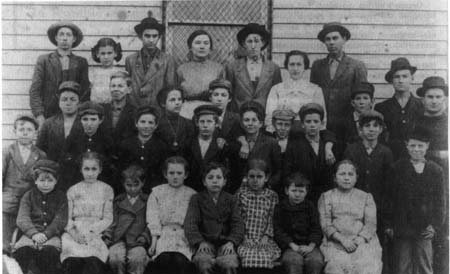
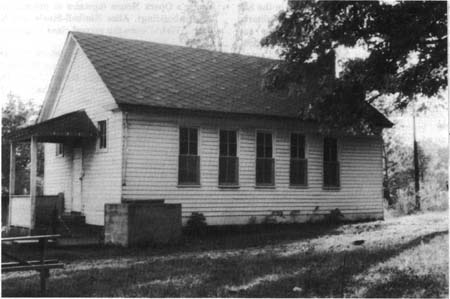
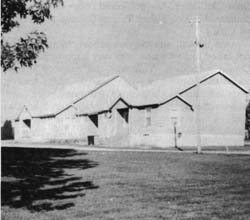 Eddyville
and Williams Shed schools, combined to form Eddyville
Community Center. Eddyville school closed in 1972. Williams
Shed school was moved from near New Home Church. These are a
later style of school architecture.
Eddyville
and Williams Shed schools, combined to form Eddyville
Community Center. Eddyville school closed in 1972. Williams
Shed school was moved from near New Home Church. These are a
later style of school architecture.